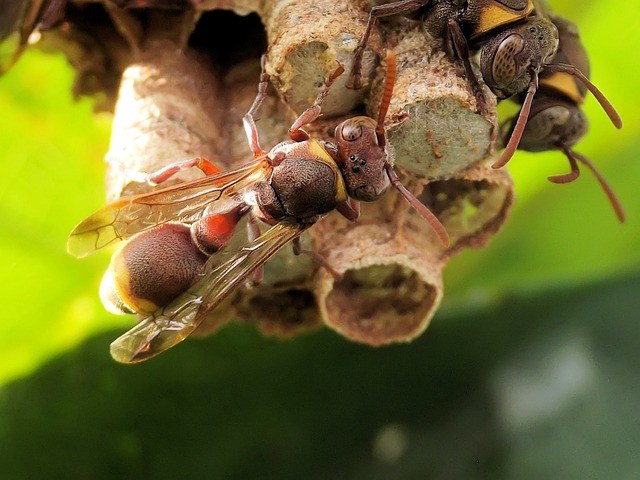Wasps, often seen as pests, play a crucial role in balancing ecosystems by controlling insect populations. Eco-friendly wasp solutions offer a safer, sustainable approach to managing these insects, avoiding toxic pesticides and promoting environmental preservation. These methods include identifying nesting sites, sealing entry points, using physical barriers, encouraging natural predators, and employing essential oils. By adopting these strategies, individuals can protect their spaces while contributing to local ecosystem conservation and biodiversity promotion. Professional green pest control services further support this harmonious coexistence.
Discover sustainable ways to manage wasps with our comprehensive guide on eco-friendly wasp removal. Learn how these insects play a vital role in ecosystems as predators and pollinators, and explore the benefits of non-toxic methods for safe and effective control. From understanding wasp behavior to practical steps and common misconceptions, we empower you with knowledge to make informed choices that protect both nature and your well-being. Embrace eco-friendly wasp solutions for a greener future.
Understanding Wasps and Their Role in Ecosystems
Wasps, often maligned as pests, play a crucial role in maintaining the balance of ecosystems. They are efficient predators, feasting on insects like caterpillars and flies, which helps control their populations. This natural form of pest management is especially beneficial for gardens and farms, where excessive insect growth can be detrimental. Moreover, wasps contribute to pollination, though they are less renowned for it than bees. Their presence indicates a healthy environment, as they thrive in areas with abundant plant life.
However, despite their ecological significance, wasp infestations in human living spaces pose safety concerns. Eco-friendly solutions offer a harmonious approach to dealing with these stinging insects. By understanding and respecting wasps’ contributions to nature, we can implement strategies that protect both humans and the environment, ensuring safe co-existence without resorting to harmful chemicals.
Benefits of Eco-Friendly Wasp Removal Techniques
Using eco-friendly wasp removal techniques offers numerous advantages for both your home and the environment. Instead of relying on toxic chemicals that can harm beneficial insects, birds, and other wildlife, these methods focus on non-lethal approaches to manage wasp populations safely. By opting for eco-friendly solutions, you contribute to preserving local ecosystems and promoting biodiversity.
Many traditional wasp control methods release synthetic pesticides into the air or apply them directly to nests, which can contaminate soil, water sources, and nearby vegetation. In contrast, eco-friendly techniques utilize natural repellents, physical barriers, and non-toxic traps designed to deter wasps without causing them harm. This not only reduces environmental pollution but also minimizes risks to human health, especially for individuals with allergies or sensitivities to chemicals.
Practical Steps for Implementing Green Wasp Control Methods
Implementing green wasp control methods involves a shift from chemical pesticides to natural, eco-friendly solutions that are both safe for the environment and effective in managing wasp populations. The first step is identifying wasps’ nesting sites around your property using non-intrusive techniques like visual inspections or pheromone traps. Once nests are located, consider options like sealing entry points or gently removing nests during off-peak hours to minimize disruption to wasp life cycles.
Physical barriers such as fine mesh netting or strategic landscaping can prevent wasps from accessing certain areas. Encouraging natural predators like birds and spiders can also help control wasp populations. Additionally, using essential oils known for their insecticidal properties—like lemon eucalyptus or peppermint—in targeted sprays offers a safe alternative to chemical pesticides. These eco-friendly wasp solutions not only protect your space but contribute to preserving local ecosystems and biodiversity.
Common Misconceptions and FAQs about Eco-Friendly Wasp Management
Many people often turn to harsh chemicals or violent methods when dealing with wasps, but it’s crucial to understand that there are eco-friendly wasp solutions available that promote safe and humane pest control. One common misconception is that all wasps are detrimental to the environment; however, most species play a vital role in pollinating plants and maintaining ecological balance. Therefore, removing wasps should be approached with caution and an understanding of their benefits.
FAQs like “Are eco-friendly wasp removal methods effective?” or “Can I handle a wasp nest myself without chemicals?” are frequently asked. The truth is, these methods can be highly effective when used correctly. Professional pest control services specializing in eco-friendly solutions employ specialized tools and knowledge to remove wasps safely while minimizing environmental impact. Additionally, understanding the types of wasps present and their behaviors can help individuals make informed decisions about whether to intervene or leave them be.
In conclusion, adopting eco-friendly wasp removal solutions not only helps preserve our natural ecosystems but also promotes a safer, more sustainable approach to pest control. By understanding wasps’ vital roles and implementing green methods, we can effectively manage these insects while minimizing environmental impact. Let’s embrace these practical steps and continue fostering a harmonious coexistence between humans and nature.
